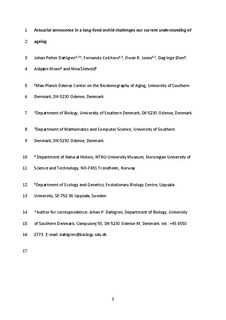| dc.contributor.author | Dahlgren, Johan P. | |
| dc.contributor.author | Colchero, Fernando | |
| dc.contributor.author | Jones, Owen R. | |
| dc.contributor.author | Øien, Dag Inge | |
| dc.contributor.author | Moen, Asbjørn | |
| dc.contributor.author | Sletvold, Nina | |
| dc.date.accessioned | 2016-11-30T11:15:45Z | |
| dc.date.accessioned | 2017-02-16T13:22:24Z | |
| dc.date.available | 2016-11-30T11:15:45Z | |
| dc.date.available | 2017-02-16T13:22:24Z | |
| dc.date.issued | 2016 | |
| dc.identifier.citation | Proceedings of the Royal Society of London. Biological Sciences 2016, 283 | nb_NO |
| dc.identifier.issn | 1471-2954 | |
| dc.identifier.uri | http://hdl.handle.net/11250/2431088 | |
| dc.description.abstract | The dominant evolutionary theory of actuarial senescence—an increase in death rate with advancing age—is based on the concept of a germ cell line that is separated from the somatic cells early in life. However, such a separation is not clear in all organisms. This has been suggested to explain the paucity of evidence for actuarial senescence in plants. We used a 32 year study of Dactylorhiza lapponica that replaces its organs each growing season, to test whether individuals of this tuberous orchid senesce. We performed a Bayesian survival trajectory analysis accounting for reproductive investment, for individuals under two types of land use, in two climatic regions. The mortality trajectory was best approximated by a Weibull model, showing clear actuarial senescence. Rates of senescence in this model declined with advancing age, but were slightly higher in mown plots and in the more benign climatic region. At older ages, senescence was evident only when accounting for a positive effect of reproductive investment on mortality. Our results demonstrate actuarial senescence as well as a survival–reproduction trade-off in plants, and indicate that environmental context may influence senescence rates. This knowledge is crucial for understanding the evolution of demographic senescence and for models of plant population dynamics. | nb_NO |
| dc.language.iso | eng | nb_NO |
| dc.publisher | The Royal Society | nb_NO |
| dc.title | Actuarial senescence in a long-lived orchid challenges our current understanding of ageing | nb_NO |
| dc.type | Journal article | nb_NO |
| dc.type | Peer reviewed | |
| dc.date.updated | 2016-11-30T11:15:45Z | |
| dc.description.version | acceptedVersion | |
| dc.source.volume | 283 | nb_NO |
| dc.source.journal | Proceedings of the Royal Society of London. Biological Sciences | nb_NO |
| dc.source.issue | 1842 | nb_NO |
| dc.identifier.doi | 10.1098/rspb.2016.1217 | |
| dc.identifier.cristin | 1406357 | |
| dc.description.localcode | author postprint available 16 November 2017 | nb_NO |
